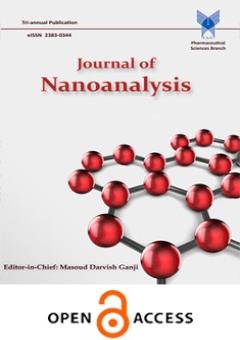-
-
List of Articles
-
Open Access Article
1 - Facile Synthesis and Investigation of Flower like p-NiO/n-ZnO as Efficient Photocatalyst for Degradation of Erythromycin under Sunlight
Sajad Khamani Mohammad Hossein Ghorbani Leila Torkian Reza Fazaeli Zahra Khodadadi -
Open Access Article
2 - Investigation of enamel surface hardness using remineralization of white spot lesions with CPP-ACP, fluoride, and CPP-ACPF
Farzaneh Shirani Shirin Rostami Parastoo Afghari -
Open Access Article
3 - Synthesis and evaluation of antibacterial properties of green copper oxide nanoparticles from Hypericum perforatum plant extract and Marrubium Vulgare
Ashkan Farazin Shirin Kavezadeh -
Open Access Article
4 - Preparation and Characterization of Silica Coated Magnetic Cu Based MOF as a Nanocarrier for Gradual Release of the Capecitabine Anticancer Drug
Azar Asgari Pari Susan Samadi Mohammad Reza__Allahgholi__Ghasri Mohammad Reza__Allahgholi__Ghasri Maryam Torbati Mohammad Yousefi -
Open Access Article
5 - The effect of acid/cellulose ratio on the quality of Cellulose Nanocrystal (CNC) suspension
Nasrin Shahmiri Nahid Hassanzadeh Nemati Ahmad Ramazani Saadatabadi Massoud Seifi -
Open Access Article
6 - The application of ZnO nanoparticles as a photocatalyst for wastewater treatment: A review
Mahdi Sanavi Fard Aref Shokri -
Open Access Article
7 - Computational investigation of adsorption of Lewisite Warfare Agents on the B12N12 and M+@B12N12 (M+ = Li+, Na+, K+) nanoclusters
Reza Ghiasi R Emami M Vasfi -
Open Access Article
8 - Evaluation of Antibacterial Effect of Zinc Oxide Nanoparticles Synthesized by Wet-chemically Method on Multidrug-resistant Uropathogenic Bacteria
Maryam Bagheri Mohammad Gholipour Monir Doudi Ali Mohammad Ahadi Gholam Reza Amiri
-
The rights to this website are owned by the Raimag Press Management System.
Copyright © 2021-2025







